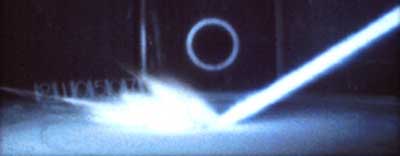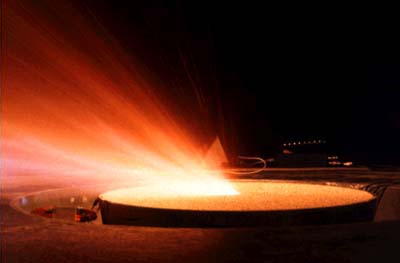 |
| Recent Evidence |
|
All asteroid-based extinctions great and small are not alike. A new study says the asteroid that struck Earth 65 million years ago and wiped out the dinosaurs was particularly deadly to North America because it hit the Yucatan peninsula from the southeast at a 20- to 30-degree angle, spreading the devastating impact of its energy northwest. The oblique angle of the asteroid's contact with Earth coupled its impact energy with that of the atmosphere and planetary surface to send waves of ground-hugging, vaporous fireballs onward, the study says. This resulted in an extinction intensity most severe downrange of the impact in North America. The researchers suggest that the relatively low angle of the Yucatan impact propelled a ballistic fireball downrange into North America. The fireball carried a two-mile-deep layer of vaporized rock and other material sheared off the Yucatan. The killing zone of matter cascaded through the atmosphere at near orbital speed, across North America and eventually around the globe. Evidence supporting this Hypothesis: Evidence #1: the researchers show that the horseshoe-shaped Yucatan crater matches the structure of craters on the moon and Venus that were created when objects struck those heavenly bodies at oblique angles. Venus's thick atmosphere holds in place gases emitted from a crater after an impact. The researchers studied images of these corked-in Venusian vapors, which show that gaseous material is propelled in waves downrange after an object strikes a planetary surface at an oblique angle. Dr. Peter Schultz, professor of geological sciences at Brown University used a high-powered gun to recreate the dynamics of an object striking Earth's surface at a 20- to 30-degree angle. The experiment produced horseshoe-shaped craters, while high-speed film captured gas and materials jettisoned downrange.
|
|
|
| Evidence
#2: the
researchers said that biological evidence appears
to support their oblique-impact hypothesis. North America, the
first region to experience the fireball, had the
most severe extinctions of plants.
After the devastation, ferns dominated the flora of central North America. Ferns accounted for 70 to 100 percent of the spore- or pollen-producing plants in the region after the impact, compared with only 10 to 40 percent before it. At the base of the food chain, plants are considered sensitive indicators of environmental devastation. Because ferns reproduce through the use of hardy spores, the plants are regarded as key flora in colonizing the site of a natural disaster. Plants in parts of the world not downrange from the impact took a lesser hit from the corridor of incineration. For example, several ancient evergreen trees found in North America before the impact, but not after, still grow in parts of Australia and South America. Modern relatives of these trees, often called "primitive conifers," include the Norfolk Island pine, Chilean monkey puzzle and Wollemi pine. "The basic point of the study is that we can determine the impact angle of this object and that the angle matters," D'Hondt said. Most scientists study the aftermath of collisions that caused Earth's craters as if objects struck the planet at 90-degree angles, or from directly overhead. But such vertical impacts are very rare. An oblique angle of impact may have more deadly global consequences than a vertical impact, because an oblique impact should release a greater fraction of impact energy to the atmosphere and surface target, said Schultz and D'Hondt. "The study also underscores the point that regional repercussions can be expected from an Earth-object impact, something scientists have rarely considered in previous studies of this 65-million-year-old event," D'Hondt said.
|
| This information was excerpted from a The Brown University News Bureau article: North America hit hard by asteroid strike in Yucatan 65 million years ago. Oct 28, 1996. |
|
|

